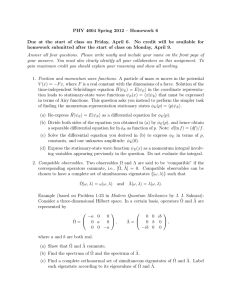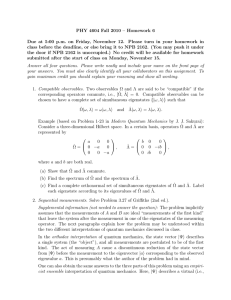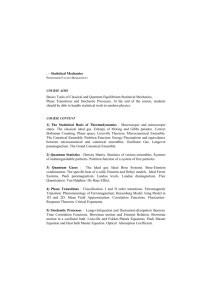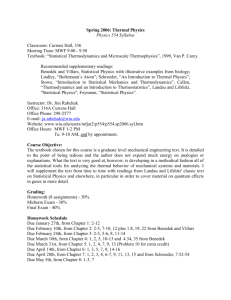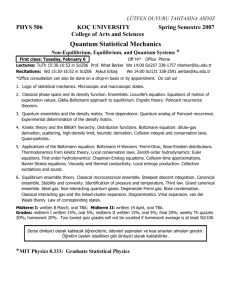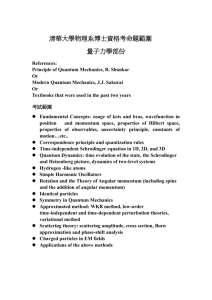PHY 4604 Fall 2008 – Homework 6
advertisement
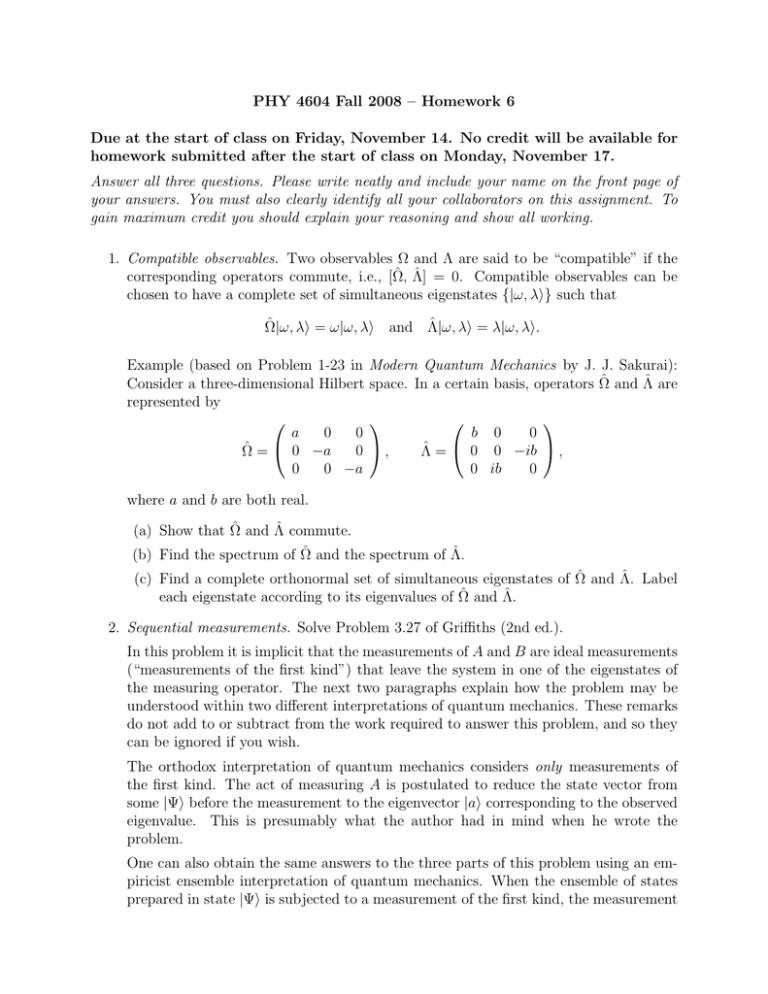
PHY 4604 Fall 2008 – Homework 6
Due at the start of class on Friday, November 14. No credit will be available for
homework submitted after the start of class on Monday, November 17.
Answer all three questions. Please write neatly and include your name on the front page of
your answers. You must also clearly identify all your collaborators on this assignment. To
gain maximum credit you should explain your reasoning and show all working.
1. Compatible observables. Two observables Ω and Λ are said to be “compatible” if the
corresponding operators commute, i.e., [Ω̂, Λ̂] = 0. Compatible observables can be
chosen to have a complete set of simultaneous eigenstates {|ω, λi} such that
Ω̂|ω, λi = ω|ω, λi and Λ̂|ω, λi = λ|ω, λi.
Example (based on Problem 1-23 in Modern Quantum Mechanics by J. J. Sakurai):
Consider a three-dimensional Hilbert space. In a certain basis, operators Ω̂ and Λ̂ are
represented by
a
0
0
b 0
0
0 ,
Ω̂ = 0 −a
Λ̂ = 0 0 −ib ,
0
0 −a
0 ib
0
where a and b are both real.
(a) Show that Ω̂ and Λ̂ commute.
(b) Find the spectrum of Ω̂ and the spectrum of Λ̂.
(c) Find a complete orthonormal set of simultaneous eigenstates of Ω̂ and Λ̂. Label
each eigenstate according to its eigenvalues of Ω̂ and Λ̂.
2. Sequential measurements. Solve Problem 3.27 of Griffiths (2nd ed.).
In this problem it is implicit that the measurements of A and B are ideal measurements
(“measurements of the first kind”) that leave the system in one of the eigenstates of
the measuring operator. The next two paragraphs explain how the problem may be
understood within two different interpretations of quantum mechanics. These remarks
do not add to or subtract from the work required to answer this problem, and so they
can be ignored if you wish.
The orthodox interpretation of quantum mechanics considers only measurements of
the first kind. The act of measuring A is postulated to reduce the state vector from
some |Ψi before the measurement to the eigenvector |ai corresponding to the observed
eigenvalue. This is presumably what the author had in mind when he wrote the
problem.
One can also obtain the same answers to the three parts of this problem using an empiricist ensemble interpretation of quantum mechanics. When the ensemble of states
prepared in state |Ψi is subjected to a measurement of the first kind, the measurement
is regarded as an additional step in the preparation procedure leading to the ensemble
describing the system after the measurement. The ensemble of systems prepared in
state |Ψi and then subjected to a measurement of A can be divided after the measurement into two sub-ensembles: the sub-ensemble of systems found to have the value
A = a1 , and the sub-ensemble of systems found to have the value A = a2 . If we wish to
make predictions for the subsequent behavior of all systems in the original ensemble,
then we should use the time-evolved version of the state vector |Ψi that described the
ensemble immediately before the measurement. However, if we wish to make predictions for the subsequent behavior of only those systems in the sub-ensemble that were
found to have A = a1 , then we should use the time-evolved version of the state vector
|a1 i, since that describes the ensemble of states subjected to the preparation procedure for |Ψi followed by the additional preparation step of being selected for having
the value A = a1 . Within this interpretation, the state vector is effectively reduced by
taking into account the additional information obtained during the measurement, but
we don’t regard this reduction as a real physical process.
3. The infinite square well in three dimensions. Consider a particle of mass m confined
by hard walls to the region of space 0 < x < ax , 0 < y < ay , 0 < z < az , inside which
the potential is zero.
(a) Write down the form of the stationary states and their energies.
(b) Consider the special case ax = ay = az = a. List each energy eigenvalue E that
satisfies E < 10π 2 ~2 /ma2 , along with the eigenvalue’s degeneracy.
